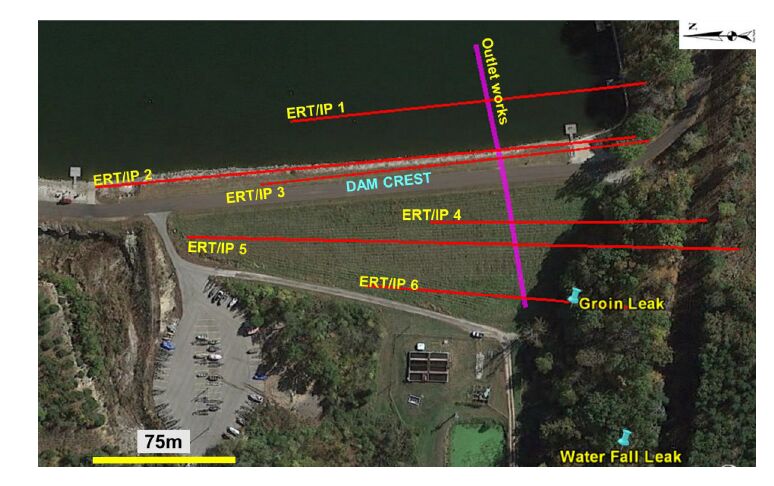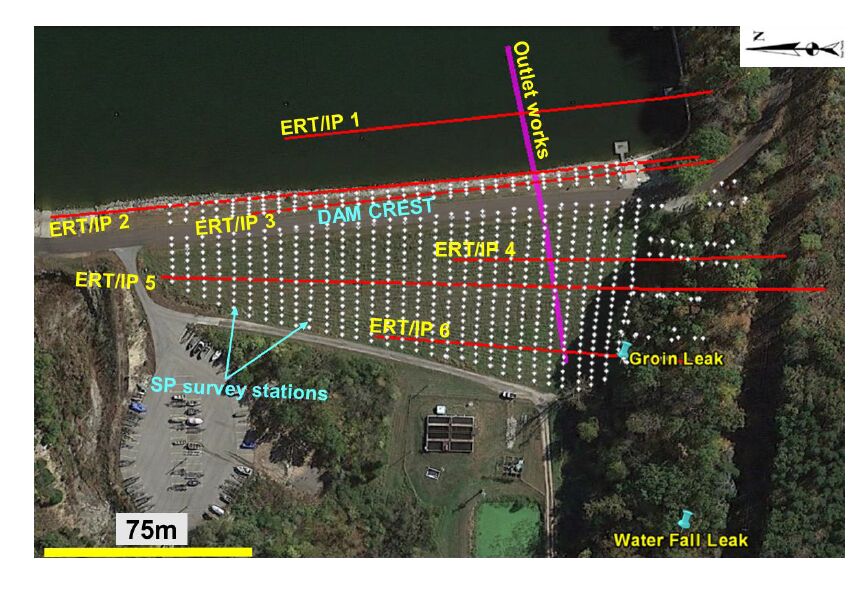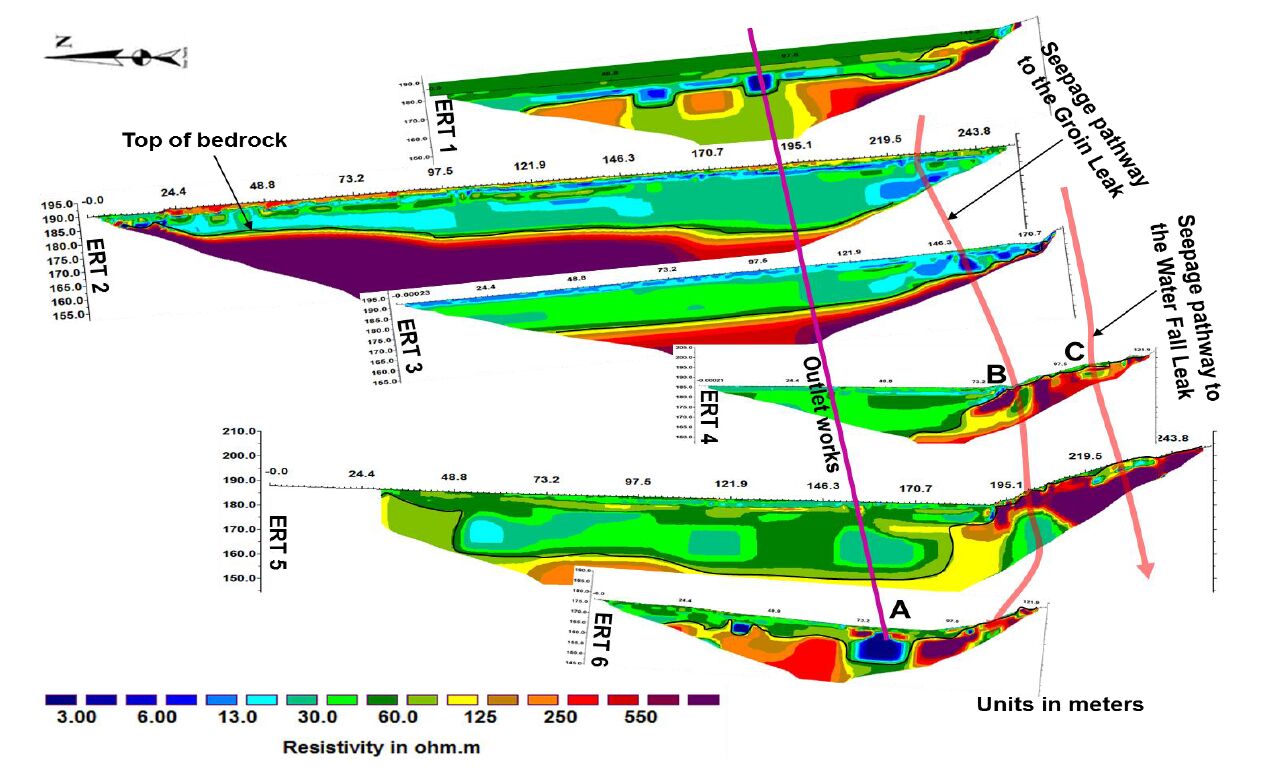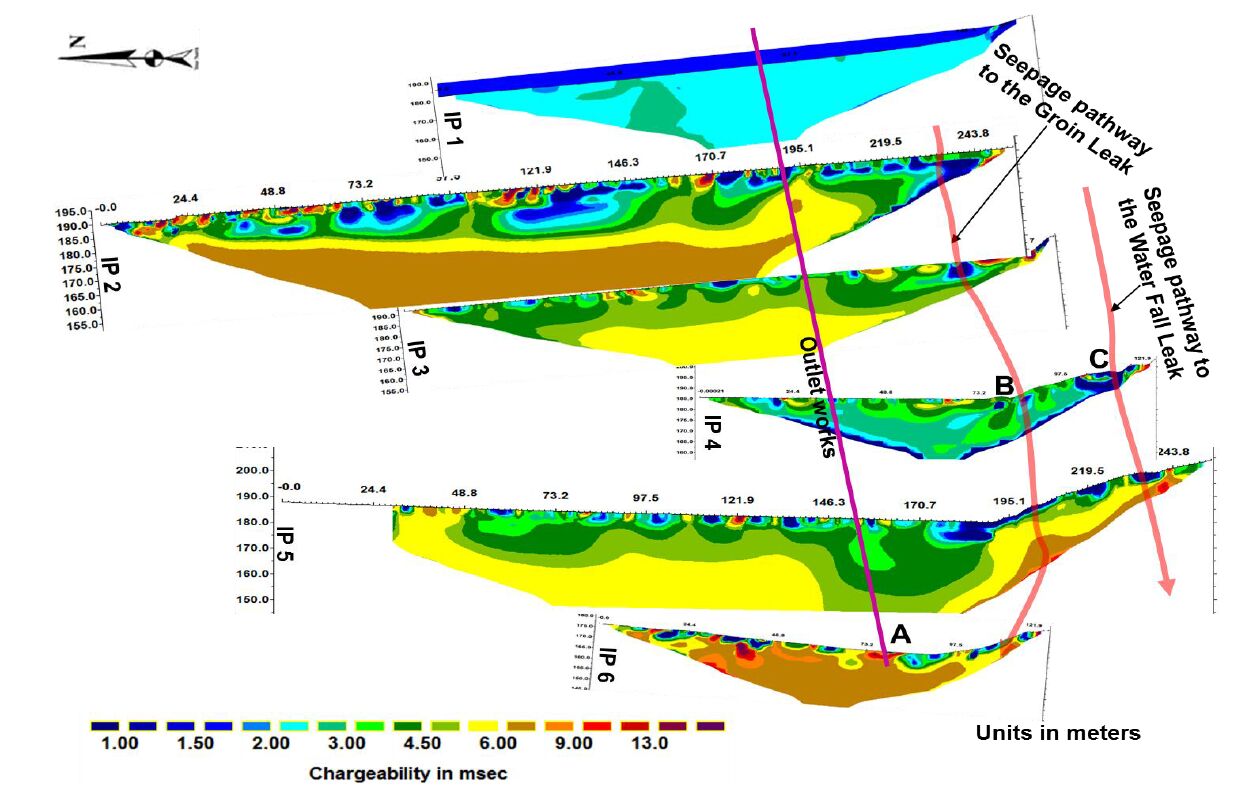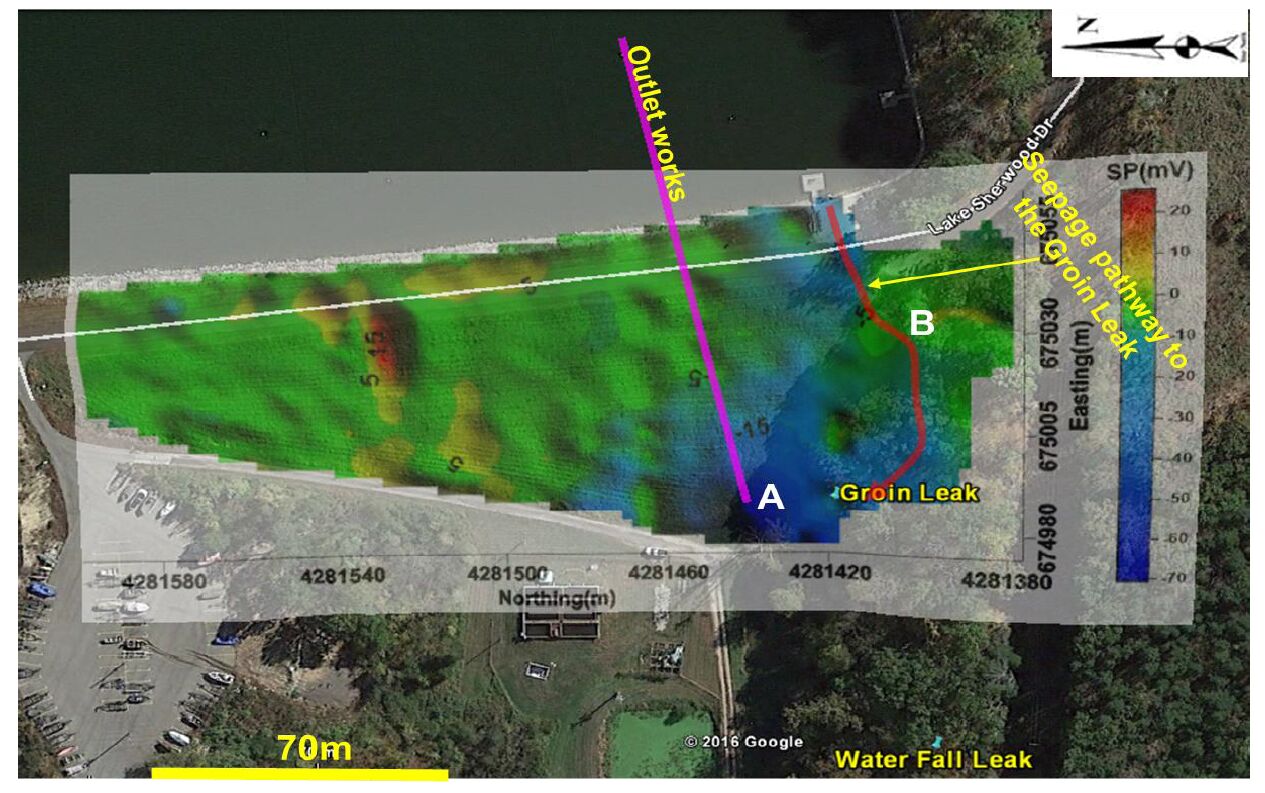1. Introduction:
According to the 2013 report of the National Inventory of Dams (NID), a biannual report published by the United States Army Corps of Engineers (USACE), the total number of dams in the United States is 87000 [1]. The report indicates that over 65 percent of the dams in the United States are more than 50 years old. Hence, aging effects increase the likelihood of the failure of these dams. The report also suggests that about 86 percent of the dams in the United States are of earth-fill type. Hence, any measures taken to reduce the chances of earthen dam failures will in turn reduce the chances of the overall dam failures in the U.S.
Ikard, Foster et al., and Ogilvy et al. conclude that most earthen dam failures are the result of seepage and internal erosion. Hence, early detection of seepage zones can help ensure that aging dams are properly maintained and that failures as a result of seepage are averted [2,3,4].
Lum and Sheffer (2005) state that temperature measurements, the spontaneous potential method, electrical resistivity tomography method and seismic methods are useful geophysical tools for earthen dam seepage investigations. Similarly, Abdel et al., Ikard, Lin et al., Nwosu and Nwankwo, Song et al., Foster et al, Reynolds, Sirles and Corwin and Butler conclude that geo-electrical geophysical tools (mainly the spontaneous potential and the electrical resistivity tomography tools) can be effectively used in investigating dam seepage [5,6,7,8,9,10,11,12,13]. Butler et al. highlight the increased use of geophysical tools in earthen dam investigations [13]. Each geophysical method has its relative strengths and weaknesses; hence, the integrated interpretation of multiple methods can decrease interpretational ambiguities.
2. Warren County Study Dam
The privately-owned Wolf Creek study dam was constructed in 1967 across Wolf Creek in Warren County, Missouri (Figure 1). The earth-fill dam has a clay core and is approximately 305m long and 21m high with a 12m wide crest. It has a maximum storage capacity of approximately 5 million m3, a surface area of 0.59 million m2 and a drainage area of 12 million m2, according to the Missouri Department of Natural Resources [14].
At the time of this investigation, there were two known seepage discharge locations downstream of the dam (Figure 1). These discharge locations are referred to as the Groin Leak and the Water Fall Leak, respectively. In 2012, the average flow rate from the Groin Leak was about 183 GPM (gallons per minute); there is no record of discharge rates from the Water Fall Leak. Discharge from the Groin Leak is continuous while flow from the Water Fall Leak terminates when the reservoir drops 3 meters below the designed maximum capacity. The owners of the dam have constructed catchment facilities to pump most of the Groin and Waterfall discharge back into the upstream reservoir. A primary objective of this investigation was to identify and map the probable seepage pathways from the upstream dam face to the Groin and Water Fall leaks so that an effective grouting program could be developed.
During site investigations, an area of moist soil and denser vegetation was identified on the downstream face of the dam above the outlet of the buried drainage pipe (outlet works). The preliminary conclusion was that the outlet works, a buried drainage pipe installed during the construction of the dam, was also leaking. A secondary objective of this investigation was to determine if the outlet works drainage pipe is leaking.
The outlet works (drainage pipe) extends from the lake to the bottom of the dam slope. The drainage pipe was installed to channel water from Wolf Creek to an area downstream section of the dam to preventing creek water from interfering with the construction of the dam. The drainage pipe inlet is located at about 19m (170m, elevation) below the design maximum water level (189m, elevation). The drainage pipe outlet is located at about 3m below the ground surface (168m, elevation).
3. Geology of Study Area
Surficial sediment in the study area is mainly alluvium and residuum from the weathering of the underlying Ordovician Joachim Formation [14]. The Joachim Formation consists mainly of yellowish-brown, argillaceous dolomite. Intermittent limestones and shales are present near the base of the formation. The Joachim Formation is approximately 50m thick in the study area (Dam Owner, personal communication) and underlain by the St. Peter Sandstone. There are evidences of the dissolution of Joachim Formation in the area, which demonstrates the formation's susceptibility to the formation of karst features such as solution-widened joints, sinkholes and caves.
4. Data Acquisition and Processing
4.1. Electrical Resistivity Tomography (ERT) Tool
Electrical resistivity (ERT) data were acquired along the six traverses shown in Figure 2 (ERT/IP 1- ERT/IP 6). The ERT traverses were different lengths depending on the number of electrodes employed and the spacing of those electrodes. For ERT Profile 1, the electrodes were spaced at ~3m (10ft), while the rest of the profiles were acquired using ~1.5m (5ft) electrode spacing. The ERT data were acquired using an AGI Supersting system [15] between June and July, 2015. A dipole-dipole electrode array was used to acquire all the six ERT profiles.
The ERT data sets were inverted using Res2DInv processing software [16] after inputting the elevation corrections and applying appropriate inversion parameters. The ERT data were relatively good quality (for data acquired in karst terrain) with RMS error values of mostly less than 10% after seven inversion iterations (Figure 4).
4.2. Induced Polarization (IP) Tool
Time-domain induced polarization (IP) data were acquired along the same six traverses using the same instruments electrodes and electrode spacings (ERT/IP 1 through ERT/IP 6; Figure 2). The IP data were inverted using Res2DInv processing software [16] after inputting the elevation corrections and applying the necessary inversion parameters. The ERT data were relatively good quality (for data acquired in karst terrain) with RMS error values of mostly less than 7% after seven inversion iterations (Figure 5).
4.3. Spontaneous Potential (SP) Tool
Spontaneous potential (SP) data were acquired in July 2015, using two saturated copper (Ⅱ) sulfate non-polarizing electrodes and a high impedance voltmeter. The 732 SP station locations are shown in Figure 3. The SP stations spacing were ~3 meters from west to east, and ~6 meters from north to south. The base (reference) electrode was placed in a forested area to the north of the dam; the lead electrode was moved progressively across the face of the dam. The SP data were used to generate an SP contour map using the Surfer software [17]. The SP data were then overlain on a Google Earth map (Figure 6).
5. Results
5.1. ERT Survey
The six interpreted ERT profiles are shown in Figure 4. Interpreted moist soil is typically characterized by resistivity values of less than 20 Ohm.m; interpreted dry soil is typically characterized by resistivity values between 20 to 60 Ohm.m; interpreted moist fractured rock with possible clay infill is characterized by resistivity values of less than 125 Ohm.m; interpreted competent less moist rock is characterized by resistivity values greater than 125 Ohm.m. The interpreted resistivity/lithologic relationships are based on field observations, borehole control and the authors' extensive experiences working with the ERT tool elsewhere in karst areas in Missouri and adjacent states.
The interpreted top of bedrock has been superposed on the six ERT profiles and three seepage zones have been tentatively identified; namely, the Outlet Works Leak, the Groin Leak and the Water Fall Leak. These three interpreted seepage pathways are labeled A, B and C, respectively (Figure 4).
Outlet Works Leak:The location of the outlet works drainage pipe has been superimposed on the ERT profiles shown in Figure 4. Based on the interpretation of ERT profile 1, it appears that the ground surface upstream of the dam was excavated prior to the installation of the outlet works and subsequently backfilled with about 5 m of relatively conductive clayey sediment. At the downstream end of the outlet works, a prominent (about 18m by 18m) zone of low resistivity (less than 20 Ohm.m) is observed (ERT/IP profile 6; Figure 4). This anomaly is attributed to the outward and downward seepage of water and clay from the outlet works pipe. The most reasonable interpretation is that the outlet works drainage pipe is leaking.
Groin Leak:The interpreted seepage pathway through the Groin Leak is shown in Figure 4. Water flowing along the interpreted Groin Leak pathway, is interpreted as seeping through the dam-bedrock interface on profiles ERT/IP 2 and ERT/IP 3. On ERT profiles ERT/IP4 to ERT/IP 6, the Groin Leak seepage pathway is interpreted as mostly through fractured rock. Discharge through the Groin Leak is attributed to significant local lateral flow (to the north) through fractured rock from the interpreted seepage pathway to the discharge location. There appears to be significant vertical seepage along the interpreted Groin Leak pathway where it intersects ERT/IP traverses 5 and 6. We note that the shallow soil at the base of the hill on ERT profiles 4 and 5 is characterized by anomalously low resistivity values (less than 13 Ohm.m). The interpreted high moisture content is attributed to discharge from the Groin Leak seepage pathway and run-off along the top of bedrock. This moisture is interpreted as seeping vertically into the soil at the base of the hill.
Water Fall Leak:The interpreted Water Fall Leak seepage pathway is shown in Figure 4. The pathway (shown only on ERT profiles 4 and 5) is interpreted to be through shallow fractured rock. The interpreted elevated and shallow flow pathway is consistent with observation that discharge through the Water Fall Leak terminates when the reservoir level falls below 3 meters of design the maximum storage capacity.
5.2. IP Survey
The six IP profiles are shown in Figure 5. The two seepage zones that were tentatively identified based on the interpretations of the ERT data are superimposed on the IP profiles (Figure 5).
Outlet Works Leak: The location of the outlet works drainage pipe has been superimposed on the IP profiles (Figure 5 The higher chargeability (> 6 m.sec) values) at the downstream end of the outlet works is attributed to the presence of the metal outlet works pipe and seepage clays. The presence of the higher IP values at the downstream end of the outlet works drainage pipe is consistent with the interpretation that the drainage pipe is leaking. This IP data interpretation is consistent with the interpretation of the ERT data.
Groin Leak:The interpreted seepage pathway through the Groin Leak on the IP profiles (Figure 5) is labeled B. The relatively low IP values along the postulated Groin Leak seepage pathway is consistent with the interpretation that the seepage pathway is relatively free of clay. The slightly higher IP values observed at depth on IP profile 5 along the postulated Groin Leak seepage pathway is consistent with the interpretation that the vertical seepage of water at this location has resulted in the deposition of piped clay.
Water Fall Leak: The interpreted Water Fall Leak seepage pathway has been superimposed on the IP profiles and labeled C. The relatively low IP values along the postulated Groin Leak seepage pathway is consistent with the interpretation that the seepage pathway is relatively free of clay
5.3. SP Survey
Seepage infiltration locations are typically characterized by negative SP anomalies; outlet locations are typically characterized by positive SP anomalies. In these respects, the SP data acquired at the site might initially appear to be counter intuitive.
Outlet works leak: the outlet works drainage pipe has been superimposed on the contoured SP map (Figure 6). The end of the outlet works, an interpreted discharge location, is characterized by a prominent negative SP anomaly. This negative anomaly is consistent with the interpretation that the discharge from the outlet works drainage pipe seeps vertically into the underlying soil and rock and is consistent with the ERT and IP interpretations.
Groin Leak:The interpreted seepage pathway through the Groin Leak (labeled B) is shown in Figure 6. The areas to the north and south of the postulated Groin Leak pathway in proximity to ERT/IP traverses 4, 5 and 6, are characterized by prominent negative anomalies. This negative anomaly is consistent with the interpretation that the discharge from the Groin Leak and run-off from the steeply dipping bedrock surface seeps vertically into the underlying soil and rock and is consistent with the ERT and IP interpretations.
6. Discussion
This investigation demonstrates that the integrated interpretation of the ERT, IP, and SP data were very useful in the detection of seepage pathways through the Wolf Creek dam.
The interpretation of the geophysical data suggests that there is high probability that the outlet works drainage pipe is leaking. The interpreted Outlet Works Leak is characterized by: 1) a low resistivity anomaly on ERT profile 6, which, suggests moisture and piped clay is seeping into the subsurface at the downstream end of the outlet works drainage pipe; 2) a high chargeability anomaly on IP profile 6 which is consistent with the presence of seepage clays; 3) a prominent negative SP anomaly which is consistent with the outward and downward flow of water from the outlet works drainage pipe into the subsurface.
The interpreted seepage pathway through the Groin Leak is characterized by: 1) low resistivity zones on ERT profiles 2 through 6 which are consistent with the seepage of water through soil and rock; 2) low chargeability zones on IP profiles 2 through 6 which are consistent with seepage through relatively clay-free seepage pathways; and 3) prominent negative anomalies which are consistent with the interpretation that the discharge from the Groin Leak and run-off from the steeply dipping bedrock surface seeps vertically into the underlying soil and rock.
The interpreted seepage through the Water Fall Leak is characterized by: 1) low resistivity zones on ERT profiles 4 and 5 suggesting the presence considerable moisture content along the zones of seepage; 2) low chargeability zones on IP profiles 4 and 5 indicating the washing away of chargeable clay materials from the zones of seepage.
It is anticipated that the results of this geophysical investigation will assist the dam owner in the planning and the designing of future remedial actions with the intent of minimizing seepage through the Wolf Creek dam.
Acknowledgments
The authors acknowledge the support of Missouri S&T graduate students Nathainail Bashir and Ghassan Alsulaimani.
Conflict of Interest
All authors declare no conflict of interest.









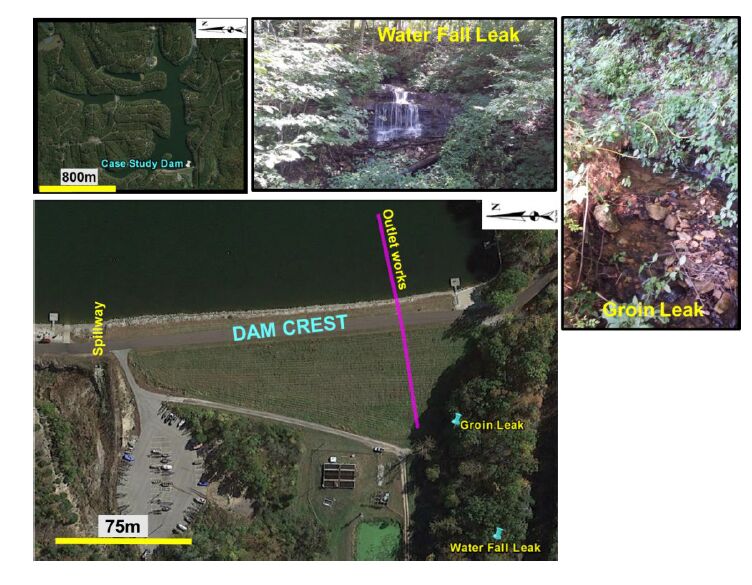
 DownLoad:
DownLoad: 